As a mother, I’ve seen firsthand how exercise can help you regain strength after pregnancy.
Being an OBGYN and fitness professional, I’ve also seen the benefits of postnatal exercise in the mothers I’ve worked with.
In this postnatal exercise introduction, I will discuss:
- The importance of postnatal exercise,
- when to start, what exercises to do,
- and tips for staying motivated!
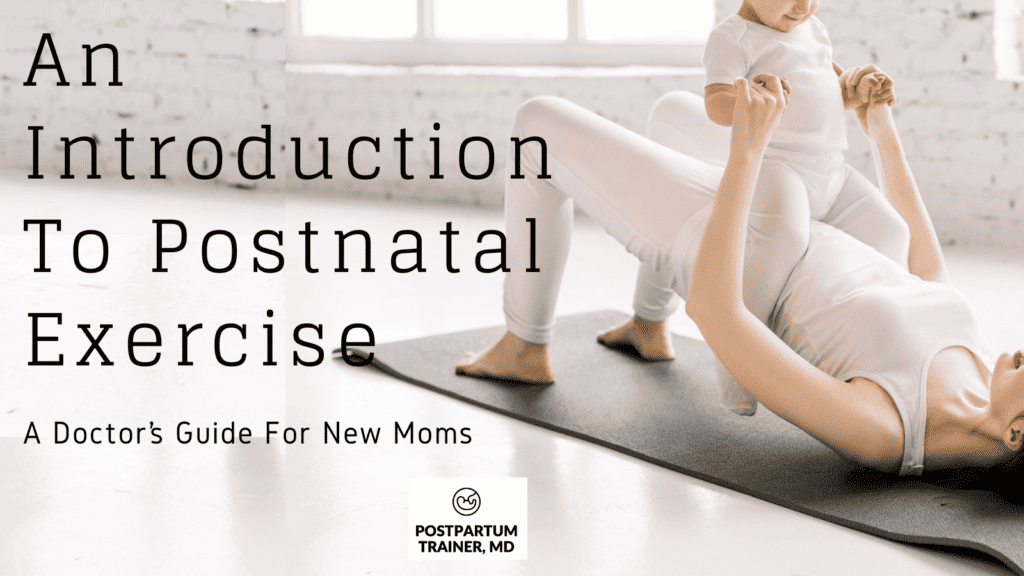
Benefits of Postnatal Exercise
Congratulations on your new baby! If you are reading this, you are probably wanting to start exercising again.
The good news is that you can usually start doing some gentle exercises as soon as you feel ready. For some women, it could be a few days after giving birth.
Postnatal exercise has many benefits for new moms, including:
- Improved mood through endorphin release which combats postpartum depression and anxiety (source).
- Restored muscle strength in the abdomen and pelvic floor, improving core stability
- Increased energy (source). Everyone knows we need energy to make parenting tasks easier!
- Weight loss through increased metabolism. It can also help prevent unwanted weight gain.
- Better quality sleep (source).
By the way, exercise won’t negatively impact breast milk production! (source)
Safety First: When to Start Exercising After Birth
It’s normal to be eager to return to exercise during the postpartum period.
But every woman is different. Every delivery is different, too.
You must listen to your healthcare professionals for guidance.
Since I was active throughout my pregnancy, I was able to start exercising one week after childbirth.
While gentle exercises like the one I describe below are safe early on, others take more time.
Most doctors will say to wait at least six weeks before trying more strenuous exercise. (source)
If you had a C-section or a difficult delivery, you will need to wait at least eight weeks.
From a medical perspective, high-impact exercise carries risks for a postpartum body.
When reintroducing exercise to your routine, consider the following points:
- Start slow: You must begin with gentle exercises. Keep the intensity and duration low and build up in a gradual manner.
- Listen to your body: Pay attention to how you feel during and after each workout. If you experience pain, discomfort, or heavy bleeding, stop!
- Stay hydrated: Be sure to drink plenty of water, especially if you are breastfeeding.
Now, let’s go over the exercises.
Getting Started with Three Gentle Exercises
Now, we will cover some gentle exercises to get you started on your postnatal fitness journey.
But first, be sure to get clearance from your healthcare provider.
Here is a list of three gentle exercises to ease back into your fitness routine.
Diaphragmatic Breathing:
Deep breathing exercises are a safe way to rebuild strength in your abdominal muscles. It is also the safest way to start treating diastasis recti.
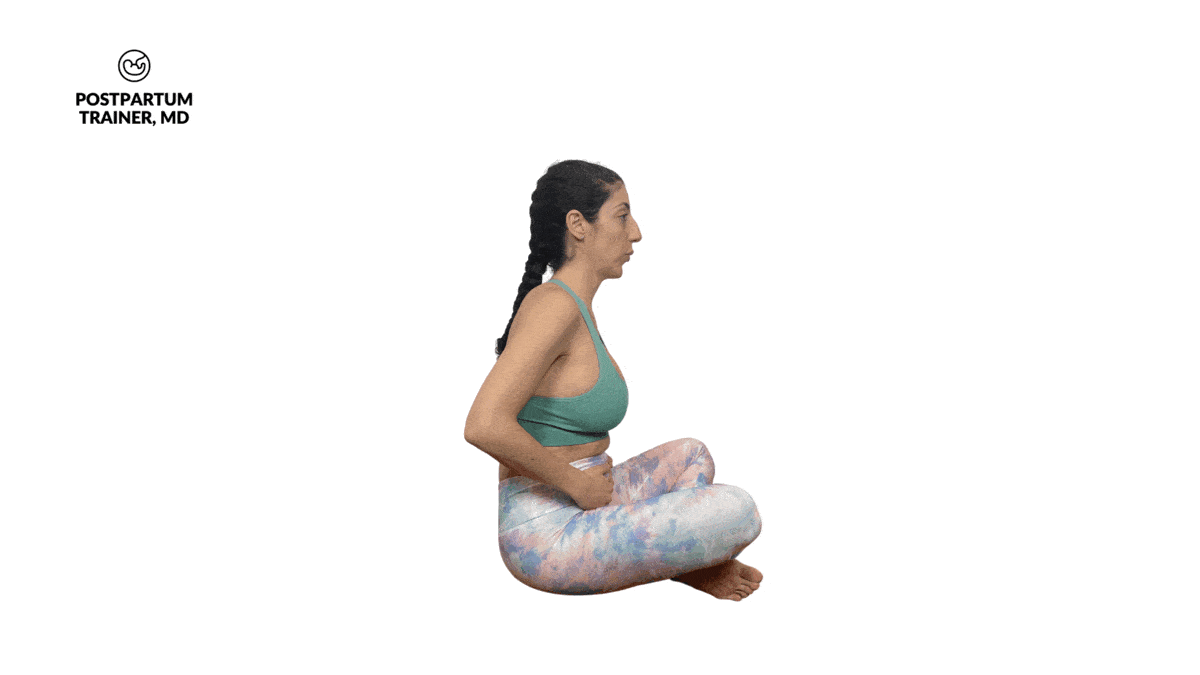
Here is how to do it:
- Take a deep inhale through your nose, filling your belly with air.
- Focus on expanding your entire midsection, especially at your sides.
- Then, exhale through your mouth, drawing your belly button towards your spine.
- Repeat this gentle exercise 3 to 5 times.
This simple exercise teaches you how to use your deep abdominal muscles. It is essential that you avoid exercises like sit-ups and crunches! Aggressive core exercises at this stage can increase abdominal wall weakness.
Pelvic Floor Exercises:
Childbirth can also weaken the pelvic floor muscles.
As an OBGYN, I’ve seen how important rebuilding the pelvic floor is for avoiding long-term issues.
Common symptoms include incontinence, pelvic organ prolapse, and discomfort during intimacy.
The best exercise to strengthen the pelvic muscles is are Kegel exercises.
It might be tricky to know how to activate these muscles. But there is one simple trick to learn the proper technique.
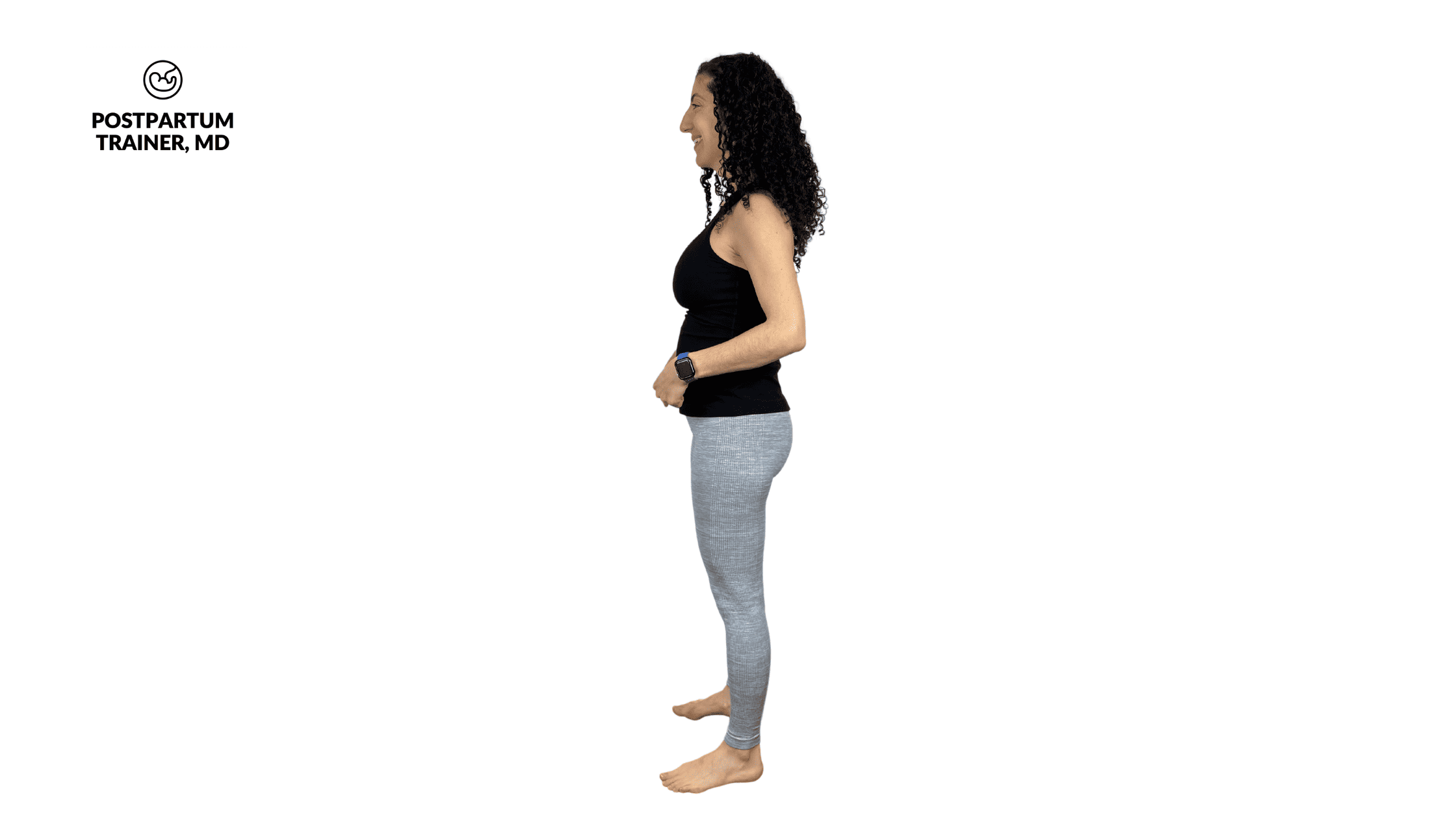
- Find the right muscles by stopping your urine mid-flow the next time you are urinating.
- Once you know how to activate them, contract the pelvic floor muscles for 5 seconds, then relax for 5 seconds
- Repeat this process 10-15 times per session, three times a day
Walking:
Walking is a low-impact way to increase your heart rate and activate the leg muscles. Start with short walks around the block in your neighborhood.
Over time, increase the distance and pace based on your comfort level.
Walking improves cardiovascular health and is a stepping stone for more intense workouts. I always guide my patients to walk first before considering jogging or running.
–
Focus on doing these three exercises for at least 1 to 3 weeks postpartum.
Keep in mind that consistency is critical!
Try to dedicate a few minutes three times a week to do these gentle exercises. Taking time to exercise will boost both your physical health and mental well-being!
More Advanced Postpartum Exercises to Consider
As you get stronger, you will want to include other types of exercises in your routine.
Below are various exercises to help you regain strength in the postnatal period.
Core and Abdominal Strengthening
After mastering deep belly breathing, you are ready for more advanced core exercises.
But not sit-ups!
Many patients don’t realize how vulnerable the abdominal muscles are postpartum.
As a doctor, I recommend avoiding sit-ups/crunches for at least 12 weeks.
Some of the best low-impact ab exercises include:
- Pelvic tilts
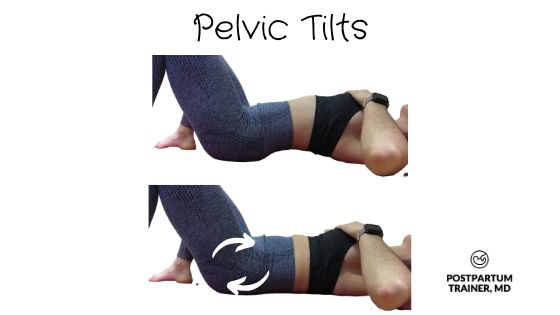
- Supine marches

- Supine heel slides
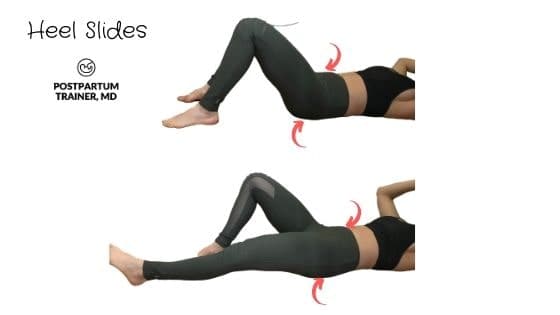
These can help increase stability, improve posture, and reduce low back pain. I go over these postnatal core exercises in more detail here.
Full-Body Strength Training
Full-body strength training will improve muscle tone and bone health while improving metabolism. Please don’t worry about getting bulky. Every woman should strength train!
The question is, how do you start?
The most effective full-body exercises include:
- Squats
- Rows
- Overhead presses
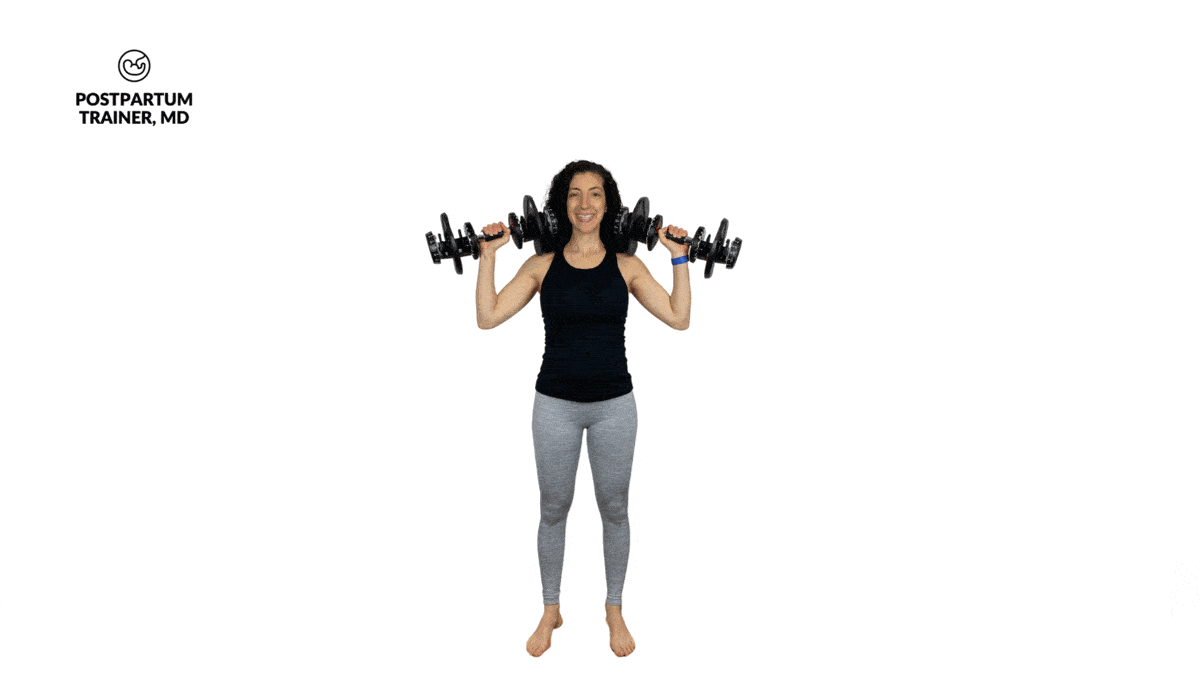
If you are new to exercise, start with lighter weights and focus on good form. Over time, increase resistance as your strength returns.
I go over these movements in more detail here: A Simple Full-Body Strength Program For New Moms
Cardiovascular Conditioning
Next is cardio. These exercises are essential for improving cardiovascular fitness and circulation.
Start with low-impact aerobic exercises like cycling or swimming. Avoid high-impact options like running at first, which can strain your core or lower back.
The best aerobic exercise options for new moms include:
Flexibility and Stretching
Finally, maintaining and improving flexibility is crucial during this period. As an OBGYN, I’ve learned how invaluable flexibility is for easing back into normal activity.
Stretching not only helps relieve muscle tension but also improves joint mobility.
I advise new moms to prioritize stretches that target these areas.
- Hamstrings
- Quadriceps
- Calves
- Upper back
- Chest
I cover some beneficial stretches in my postnatal yoga post!
Remember to be gentle with your body as it undergoes postnatal changes. Always consult your healthcare provider before commencing any exercise program.
Creating Your Postpartum Exercise Plan
Easing into exercise postpartum requires patience. Start by making physical activity a regular part of your daily routine. Aim to exercise at least three times per week, even if just for 10-15 minutes each session.
Begin each session with gentle movements and a light warm-up.
Then, focus on lower-impact exercise options, like
- walking,
- pelvic tilts,
- and light strength exercises using your body weight.
I also have a comprehensive workout program that follows these principles. It takes you week by week through a series of postnatal exercises for rebuilding strength. Each exercise also has a short video to ensure you are doing it right!
Always listen to your body and stop if you feel any pain or discomfort. Feel free to include some stretching after each session to aid flexibility as you heal. Over time, you can increase the duration and intensity of your workouts.
A Quick Note On Breastfeeding
If you are breastfeeding, make sure to stay well hydrated to maintain your milk supply. Aim to drink approximately half of your body weight in ounces of water each day.
How To Stay Motivated
Consistency is vital – don’t push yourself too hard.
On the days I didn’t feel like exercising, I reminded myself of how great I felt afterward. You never regret exercising. Trust me :).
Also, celebrate small wins.
For example, celebrate when you can hold an exercise or add an extra repetition each week. Building a routine you enjoy will help with motivation. Remember that every little bit of activity makes a difference to your health.
What Are The Potential Risks of Postpartum Exercises?
While exercise has many benefits after giving birth, there are some cautions to keep in mind:
- Overexertion: Excessive high-intensity exercise can lead to complications like prolonged bleeding and fatigue. Always listen to your body and check in with your doctor to ensure you can continue.
- Injury: Jumping into aggressive workouts too soon increases injury risk. Remember that your joints and ligaments also need to recover postpartum.
- Worsening diastasis recti: Intense ab workouts can worsen muscle separation. It would help if you focused on diastasis recti-safe exercises.
To stay safe, always consult your provider before starting any postnatal exercise program. Also, be sure to allow enough healing time after delivery.
Conclusion
Returning to an exercise routine postpartum takes time.
A gradual approach works best before attempting any new exercises after pregnancy. When in doubt, start with gentle exercises like walking and pelvic floor exercises.
With time, you can incorporate more intense workouts like cardio and weight training.
Consistency is key, so aim for at least three weekly sessions and celebrate small wins.
Get Four Free Workouts To Help Strengthen Your Pelvic Floor & Heal Your Mommy Tummy!

Brittany Robles, MD, MPH, CPT
Brittany Robles is a full-time OBGYN physician, a NASM certified trainer, and a prenatal and postnatal fitness specialist. She holds a Master of Public Health degree in maternal health with a special interest in exercise and nutrition. She is also the co-author of The White Coat Trainer. Learn more about her here.
Sharing is Caring – Send This To A Mom In Need!
